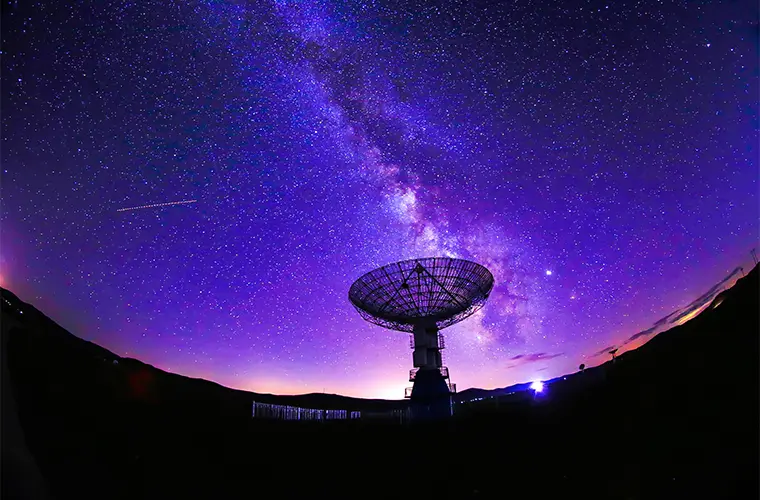A recent study by Penn State University astronomers has pushed the search for extraterrestrial life to new heights, using advanced technology to scour the TRAPPIST-1 star system for elusive radio signals.
Despite no confirmed alien signals, the effort marks a significant leap in the search for intelligent life beyond Earth, thanks to the most extended radio technosignature search conducted on a single target to date. The research team’s findings were accepted for publication in the Astronomical Journal and made available in preprint on arXiv.
“This research shows that we are getting closer to technology and methods that could detect radio signals similar to the ones we send into space,” Nick Tusay, a graduate student research fellow at Penn State and first author of the study, said in a press release.
“Most searches assume a powerful signal, like a beacon intended to reach distant planets, because our receivers have a sensitivity limit to a minimum transmitter power beyond anything we unintentionally send out. But, with better equipment, like the upcoming Square Kilometer Array, we might soon be able to detect signals from an alien civilization communicating with its spacecraft,” Tusay said.
The quest for uncovering extraterrestrial intelligence (ETI) has taken an ambitious step forward, with a team of Penn State researchers leading a novel search for radio technosignatures—signals potentially generated by advanced civilizations—around the TRAPPIST-1 star system.
Conducted with the Allen Telescope Array (ATA), this 28-hour search marks the most extensive single-target investigation ever undertaken in the search for extraterrestrial intelligence (ETI). The researchers also pioneered a new method for detecting technosignatures, establishing fresh limits on the potential for artificial radio emissions in our cosmic neighborhood.
TRAPPIST-1: A Perfect Target for Alien Life
TRAPPIST-1, located in the constellation Aquarius 40.66 light-years away from Earth, is a cool M-dwarf star hosting seven known terrestrial planets. These planets are of great interest because they are closely packed and include worlds that may harbor liquid water under the right conditions—an essential ingredient for life as we know it.
The TRAPPIST-1 system’s compactness and near-perfect alignment from our viewpoint make it a prime candidate for studying phenomena like planet-planet occultations (PPOs), where one planet crosses in front of another.
Nick Tusay, the study’s lead author, noted that TRAPPIST-1 provides a “unique laboratory” for studying exoplanet systems. It offers an opportunity to probe not only for natural radio emissions but also for potential “spillover” radio signals from hypothetical extraterrestrial technologies.
“The methods and algorithms that we developed for this project,” explained Tusay, “can eventually be applied to other star systems and increase our chances of finding regular communications among planets beyond our solar system, if they exist.”
Technosignatures are signs that might indicate the presence of advanced technological civilizations. These could include a range of signals, from artificial light sources to industrial pollutants, but radio technosignatures—narrowband signals produced by non-natural processes—are a primary focus of modern SETI (Search for Extraterrestrial Intelligence) efforts.
The ATA, a 42-dish array based in Hat Creek, California, was recently upgraded with new hardware designed specifically to enhance SETI research. Over a two-week period in late 2022, the team used ATA’s narrowband signal detection capabilities to scan TRAPPIST-1 for potential technosignatures in the 0.9–9.3 GHz frequency range.
Planet-Planet Occultations and Radio Spillover
One of the study’s most innovative aspects was its focus on PPOs—events where one exoplanet blocks another. These occurrences could potentially act as “radio beacons” if an advanced civilization on one planet were sending radio signals to another planet in the same system. In such cases, Earth might be positioned to intercept these signals, offering a brief but valuable window for detecting transmissions for extraterrestrial intelligence.
Tusay and his colleagues used sophisticated software to predict possible PPO events during their observation window, calculating when Earth might be in the right spot to pick up these transmissions. The team then conducted an extensive scan across a wide range of frequencies, searching for narrowband signals—radio transmissions that could potentially indicate the presence of alien technology.
Filtering the data to approximately 11,000 candidates for detailed analysis of millions of possible signals, of these, 2,264 signals were detected during moments when the alignment of planets in the TRAPPIST-1 system might allow Earth to intercept potential transmissions.
However, none of the detected signals were revealed to be extraterrestrial origin on further investigation, with all tracing back to human-made interference.
TRAPPIST-1 Helping Set New Limits on Detection
While the absence of detected alien technosignatures might seem disappointing at first glance, the research yielded significant results in terms of defining the limits of what the team could detect.
The ATA’s sensitivity was calculated to be capable of detecting signals with an Effective Isotropic Radiated Power (EIRP) ranging from 2.17 terawatts to 421 terawatts, depending on the signal’s drift rate and frequency. This means that if an extraterrestrial civilization in the TRAPPIST-1 system was using a transmitter with power similar to our deep-space probes, the search would likely have found it.
These findings expanded our understanding of the boundaries of radio technosignature searches, offering clearer insights into the types of signals that can be ruled out and the improvements needed for future searches.
The researchers’ work is part of a growing trend in SETI to leverage advanced technologies and methods for a more targeted and efficient search.
Historically, SETI has been plagued by radio frequency interference (RFI) from Earth-based sources, making it challenging to identify genuine extraterrestrial signals. By using beamforming techniques that isolate signals originating from specific points in the sky, the team was able to filter out much of the noise that typically complicates these searches.
The researchers also employed a novel filtering algorithm, NbeamAnalysis, which reduced the number of candidate signals from 25 million to just over 11,000. Of these, 2,264 signals coincided with the predicted PPO windows, allowing the researchers to home in on the most promising possibilities.
Although the search did not result in the detection of extraterrestrial life, it is a critical step forward in refining SETI techniques and understanding the challenges ahead. As technology improves and our understanding of exoplanet systems deepens, future searches will likely focus on systems like TRAPPIST-1, which offers multiple planets and the potential for complex, life-supporting environments.
Ultimately, the researchers say their work sets the stage for future observations using even more advanced arrays, such as the upcoming Square Kilometer Array (SKA), dramatically increasing the search’s sensitivity and allowing for more comprehensive monitoring of systems like TRAPPIST-1.
“The analysis of the observations presented here demonstrates that precise characterization of ideal systems, like TRAPPIST-1, enabling orbital dynamical modeling and prediction of PPO events offer practical application for leaked emission searches,” the team wrote. “This provides SETI a powerful new observational tool and search strategy. As signal detection and RFI mitigation pipelines improve, the inclusion of PPOs to provide narrow search windows may make it more feasible to increase time resolution and sensitivity at higher drift rates.”
“[The] Detection of leaked radio emission from nearby planetary systems may be on the horizon.”
Tim McMillan is a retired law enforcement executive, investigative reporter and co-founder of The Debrief. His writing typically focuses on defense, national security, the Intelligence Community and topics related to psychology. You can follow Tim on Twitter: @LtTimMcMillan. Tim can be reached by email: tim@thedebrief.org or through encrypted email: LtTimMcMillan@protonmail.com

